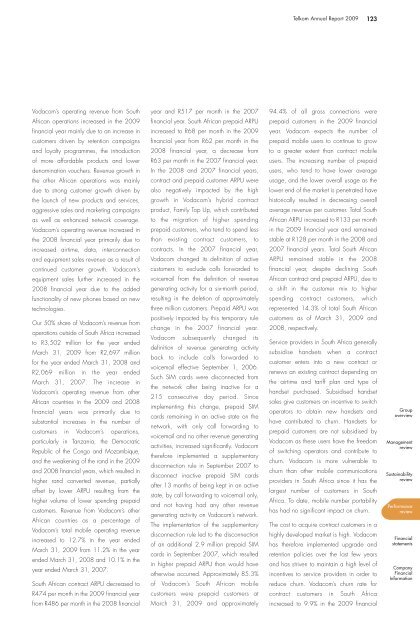Telkom AR front.qxp
Telkom AR front.qxp
Telkom AR front.qxp
Create successful ePaper yourself
Turn your PDF publications into a flip-book with our unique Google optimized e-Paper software.
Vodacom’s operating revenue from South<br />
African operations increased in the 2009<br />
financial year mainly due to an increase in<br />
customers driven by retention campaigns<br />
and loyalty programmes, the introduction<br />
of more affordable products and lower<br />
denomination vouchers. Revenue growth in<br />
the other African operations was mainly<br />
due to strong customer growth driven by<br />
the launch of new products and services,<br />
aggressive sales and marketing campaigns<br />
as well as enhanced network coverage.<br />
Vodacom’s operating revenue increased in<br />
the 2008 financial year primarily due to<br />
increased airtime, data, interconnection<br />
and equipment sales revenue as a result of<br />
continued customer growth. Vodacom’s<br />
equipment sales further increased in the<br />
2008 financial year due to the added<br />
functionality of new phones based on new<br />
technologies.<br />
Our 50% share of Vodacom’s revenue from<br />
operations outside of South Africa increased<br />
to R3,502 million for the year ended<br />
March 31, 2009 from R2,697 million<br />
for the year ended March 31, 2008 and<br />
R2,069 million in the year ended<br />
March 31, 2007. The increase in<br />
Vodacom’s operating revenue from other<br />
African countries in the 2009 and 2008<br />
financial years was primarily due to<br />
substantial increases in the number of<br />
customers in Vodacom’s operations,<br />
particularly in Tanzania, the Democratic<br />
Republic of the Congo and Mozambique,<br />
and the weakening of the rand in the 2009<br />
and 2008 financial years, which resulted in<br />
higher rand converted revenue, partially<br />
offset by lower <strong>AR</strong>PU resulting from the<br />
higher volume of lower spending prepaid<br />
customers. Revenue from Vodacom’s other<br />
African countries as a percentage of<br />
Vodacom’s total mobile operating revenue<br />
increased to 12.7% in the year ended<br />
March 31, 2009 from 11.2% in the year<br />
ended March 31, 2008 and 10.1% in the<br />
year ended March 31, 2007.<br />
South African contract <strong>AR</strong>PU decreased to<br />
R474 per month in the 2009 financial year<br />
from R486 per month in the 2008 financial<br />
year and R517 per month in the 2007<br />
financial year. South African prepaid <strong>AR</strong>PU<br />
increased to R68 per month in the 2009<br />
financial year from R62 per month in the<br />
2008 financial year, a decrease from<br />
R63 per month in the 2007 financial year.<br />
In the 2008 and 2007 financial years,<br />
contract and prepaid customer <strong>AR</strong>PU were<br />
also negatively impacted by the high<br />
growth in Vodacom’s hybrid contract<br />
product, Family Top Up, which contributed<br />
to the migration of higher spending<br />
prepaid customers, who tend to spend less<br />
than existing contract customers, to<br />
contracts. In the 2007 financial year,<br />
Vodacom changed its definition of active<br />
customers to exclude calls forwarded to<br />
voicemail from the definition of revenue<br />
generating activity for a six-month period,<br />
resulting in the deletion of approximately<br />
three million customers. Prepaid <strong>AR</strong>PU was<br />
positively impacted by this temporary rule<br />
change in the 2007 financial year.<br />
Vodacom subsequently changed its<br />
definition of revenue generating activity<br />
back to include calls forwarded to<br />
voicemail effective September 1, 2006.<br />
Such SIM cards were disconnected from<br />
the network after being inactive for a<br />
215 consecutive day period. Since<br />
implementing this change, prepaid SIM<br />
cards remaining in an active state on the<br />
network, with only call forwarding to<br />
voicemail and no other revenue generating<br />
activities, increased significantly. Vodacom<br />
therefore implemented a supplementary<br />
disconnection rule in September 2007 to<br />
disconnect inactive prepaid SIM cards<br />
after 13 months of being kept in an active<br />
state, by call forwarding to voicemail only,<br />
and not having had any other revenue<br />
generating activity on Vodacom’s network.<br />
The implementation of the supplementary<br />
disconnection rule led to the disconnection<br />
of an additional 2.9 million prepaid SIM<br />
cards in September 2007, which resulted<br />
in higher prepaid <strong>AR</strong>PU than would have<br />
otherwise occurred. Approximately 85.3%<br />
of Vodacom’s South African mobile<br />
customers were prepaid customers at<br />
March 31, 2009 and approximately<br />
<strong>Telkom</strong> Annual Report 2009 123<br />
94.4% of all gross connections were<br />
prepaid customers in the 2009 financial<br />
year. Vodacom expects the number of<br />
prepaid mobile users to continue to grow<br />
to a greater extent than contract mobile<br />
users. The increasing number of prepaid<br />
users, who tend to have lower average<br />
usage, and the lower overall usage as the<br />
lower end of the market is penetrated have<br />
historically resulted in decreasing overall<br />
average revenue per customer. Total South<br />
African <strong>AR</strong>PU increased to R133 per month<br />
in the 2009 financial year and remained<br />
stable at R128 per month in the 2008 and<br />
2007 financial years. Total South African<br />
<strong>AR</strong>PU remained stable in the 2008<br />
financial year, despite declining South<br />
African contract and prepaid <strong>AR</strong>PU, due to<br />
a shift in the customer mix to higher<br />
spending contract customers, which<br />
represented 14.3% of total South African<br />
customers as of March 31, 2009 and<br />
2008, respectively.<br />
Service providers in South Africa generally<br />
subsidise handsets when a contract<br />
customer enters into a new contract or<br />
renews an existing contract depending on<br />
the airtime and tariff plan and type of<br />
handset purchased. Subsidised handset<br />
sales give customers an incentive to switch<br />
operators to obtain new handsets and<br />
have contributed to churn. Handsets for<br />
prepaid customers are not subsidised by<br />
Vodacom as these users have the freedom<br />
of switching operators and contribute to<br />
churn. Vodacom is more vulnerable to<br />
churn than other mobile communications<br />
providers in South Africa since it has the<br />
largest number of customers in South<br />
Africa. To date, mobile number portability<br />
has had no significant impact on churn.<br />
The cost to acquire contract customers in a<br />
highly developed market is high. Vodacom<br />
has therefore implemented upgrade and<br />
retention policies over the last few years<br />
and has striven to maintain a high level of<br />
incentives to service providers in order to<br />
reduce churn. Vodacom’s churn rate for<br />
contract customers in South Africa<br />
increased to 9.9% in the 2009 financial<br />
Group<br />
overview<br />
Management<br />
review<br />
Sustainability<br />
review<br />
Performance<br />
review<br />
Financial<br />
statements<br />
Company<br />
Financial<br />
Information




